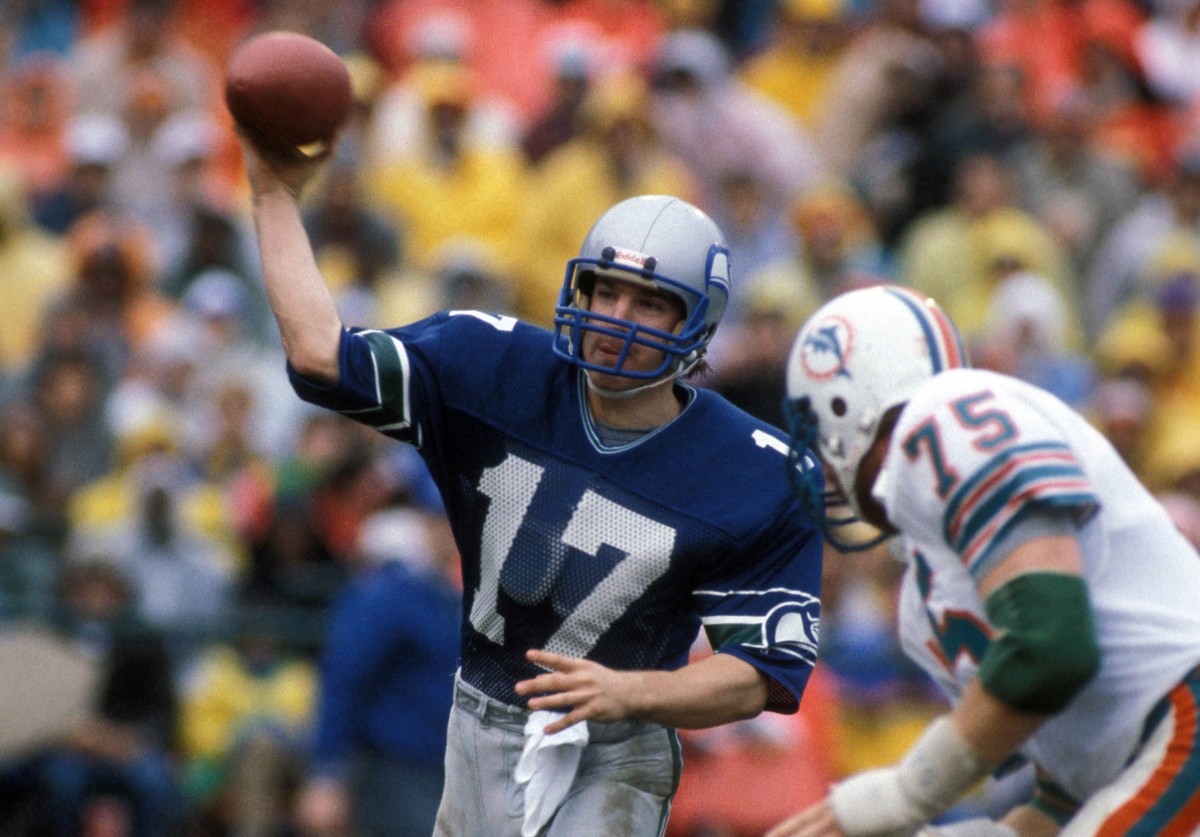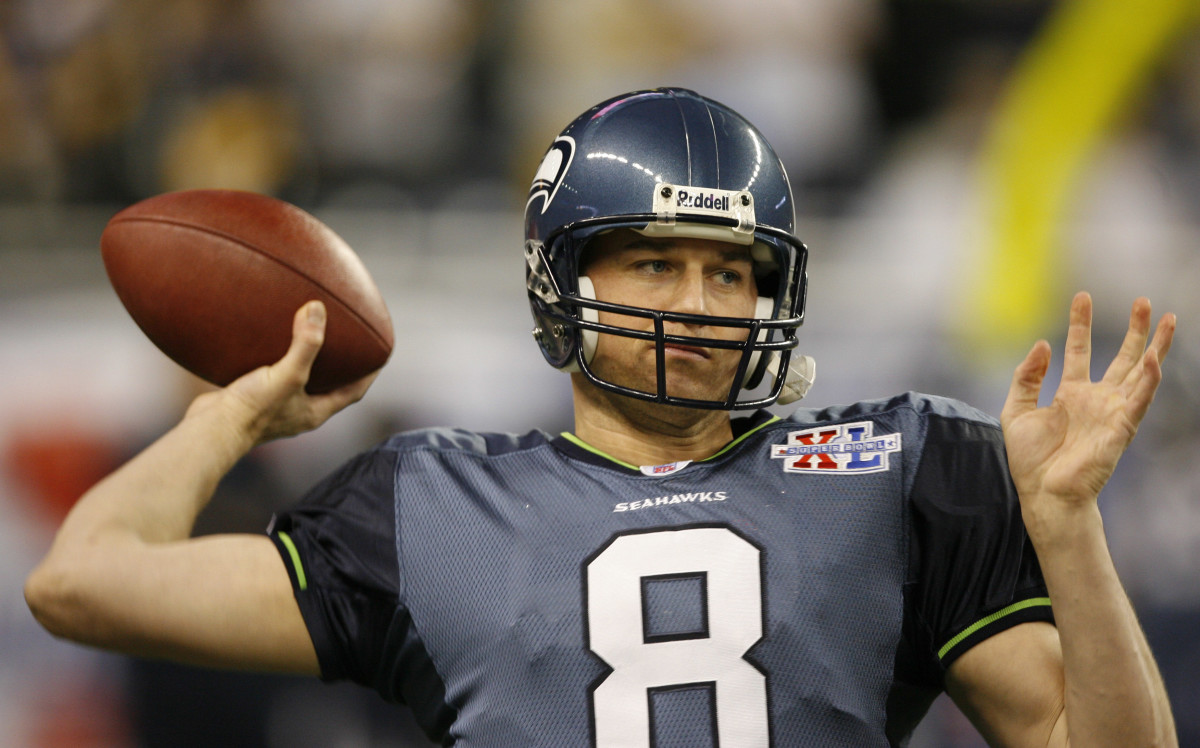Revisiting Notable Quarterback Changes in Seahawks History
When it comes to finding a franchise quarterback, the task can be incredibly elusive for NFL teams. You either have one or you don't, which is why trading one away in the midst of his prime has rarely happened during the league's history.
However, times appear to be changing. With players carrying more power than ever before and salaries at the position escalating to borderline salary cap-hindering levels, a new trend appears to be in vogue with star quarterbacks changing zip codes. Last year, Matthew Stafford joined the Rams via trade after 12 years with the Lions and immediately won a Super Bowl.
Seeing Stafford and Tom Brady win Lombardi Trophies in their first year with new teams, Russell Wilson explored his options and ultimately decided he wanted his own change of scenery hoping for a similar result. After years of rumors and speculation, the Seahawks obliged, dealing him to the Broncos last month for two first-round picks, two second-round picks, a fifth-round pick, and three veteran players, including quarterback Drew Lock.
With Wilson officially in the Mile High City, Seattle now finds itself in a position no team wants to be in searching for a new quarterback. But this isn't the first time, nor will it be the last time, the franchise undergoes a changing of the guard under center.
Looking back at their history dating back to their inaugural season back in 1976, how has passing the torch from one quarterback to the next played out for the Seahawks? Here's a look at several noteworthy transitions at the most important position in professional sports:
1984: Jim Zorn finally cedes starting role to Dave Krieg

Performing admirably while at the controls for an expansion team, Zorn served as a full-time starter during each of Seattle's first seven seasons. During that time, the franchise improved from a dreadful 2-12 record in its inaugural season to respectable 9-7 records in 1978 and 1979. However, the team couldn't get over the hump to make the playoffs for the first time and won a combined 20 games over the next two seasons, including going 4-5 during a strike-shortened 1982 campaign.
After starting five games in his first three NFL seasons coming out of tiny Milton College, the Seahawks handed the keys to Krieg midway through a Week 8 loss to the Steelers with hopes he could take their offense to another level. While there were a few hiccups along the way, the gunslinger led the team to five wins in eight starts, helping them earn their first playoff berth in franchise history. From there, he threw four touchdowns in playoff road wins over the Broncos and Dolphins, guiding them to a shocking AFC Championship Game berth before losing to the Raiders.
Over the next eight seasons, Krieg would start 106 games for Seattle and emerge as the franchise's first star quarterback, throwing for over 22,000 yards and 168 touchdowns while earning Pro Bowl honors three times. Though he never could steer his team back to the AFC Championship Game, they reached the postseason three times in his first five seasons as a full-time starter.
1992: Krieg walks and Seahawks enter quarterback purgatory...

After Seattle narrowly missed out on a playoff berth with a 9-7 record in 1990, the team used its first round pick in 1991 on San Diego State quarterback Dan McGwire, believing he would eventually succeed Krieg. The veteran then suffered a broken thumb in the season opener, causing him to miss six games with Jeff Kemp and Kelly Stouffer filling in as injury replacements. Upon his return, with an aging, depleted roster around him, the Seahawks lost five of their final seven games with Krieg under center to finish a dismal 7-9.
Ready to hit the reset button, general manager Tom Flores took over for long-time coach Chuck Knox and opted to keep Stouffer and McGwire while letting Krieg leave in free agency. That decision proved to be an ill-advised one, as the veteran led the Chiefs to a playoff berth the following season and the Seahawks scuffled to a franchise-worst 2-14 record behind the NFL's worst offense. Stouffer, journeyman Stan Gelbaugh, and McGwire combined to throw nine touchdowns and 23 interceptions, leading the team to invest another first-round pick in Notre Dame's Rick Mirer the following draft.
Showing some promise as a rookie, Mirer threw for nearly 3,000 yards in 1993, helping Seattle improve its record to 6-10. The following season, he threw just seven interceptions but the team went 5-8 in his 13 starts and he barely completed north of 50 percent of his pass attempts. From there, everything went downhill for the former Fighting Irish star as he threw 32 interceptions compared to 18 touchdowns in his final two seasons with the franchise and eventually lost his job to veteran John Friesz. In his four seasons as a starter, the Seahawks never finished better than 8-8.
1997: An aging Warren Moon provides short-term stability

After five seasons of toiling in the cellar of the AFC West in large part due to horrific quarterback play, the Seahawks didn't go back to the draft well to fill the void this time around. With Bob Whitsitt taking over as general manager, the team instead used their two first-round picks on future Hall of Fame tackle Walter Jones and cornerback Shawn Springs. Under center, they brought in the 41-year old Moon, who was coming off a challenging final season with the Vikings in which he had lost his starting job to Brad Johnson.
Showing he had plenty of life left in his arm in his return to the Pacific Northwest, Moon was revitalized in his old stomping grounds as he bounced back with 25 passing touchdowns and made his ninth and final Pro Bowl. Unfortunately, his arrival wasn't enough to vault Seattle back to the playoffs as a 22nd-ranked defense held the team back to another disappointing 8-8 record and a third-place finish in the AFC West.
The following season, Moon couldn't replicate his production and after the Seahawks went 4-6 in his first 10 starts, coach Dennis Erickson benched him in favor of second-year quarterback Jon Kitna. After Erickson was replaced by former Packers coach Mike Holmgren, the ex-Central Washington standout would start 27 games over the next two seasons, throwing 41 touchdowns and helping the team win an AFC West title in 1999.
2001: After a rough start, Matt Hasselbeck carries Seattle to new heights

Though Kitna had elevated the Seahawks to a playoff berth in his first full season as a starter, he regressed significantly in 2000 with 19 interceptions and the Seahawks took a big step back finishing 6-10. Understanding the team needed to upgrade the most important position in professional sports, Holmgren orchestrated a trade to acquire Hasselbeck and a first-round pick from the Packers, sending a first-round and third-round pick back to his former employer.
Initially, Hasselbeck didn't play like a long-term answer for Seattle. He threw two interceptions in his starting debut and following two poor outings against Philadelphia and Oakland, Holmgren benched him in favor of veteran Trent Dilfer. He eventually regained the starting job, but struggled with just seven touchdowns in 12 starts before Dilfer started the final two games. Then in 2002, Hasselbeck was benched again after the season opener and Dilfer started six straight games before tearing his Achilles tendon.
With another chance to prove himself, Hasselbeck finished 2002 with a bang, throwing for 2,766 yards and 13 touchdowns in nine starts. From there, he broke out in 2003 with 26 touchdown passes to lead the Seahawks to an NFC West title and earned his first Pro Bowl. Two years later, he guided the franchise to their first Super Bowl appearance and in 10 seasons with the organization, he tossed 174 touchdowns, made three Pro Bowls, and helped Seattle make the playoffs six times.
2012: An unlikely superstar emerges in the form of Russell Wilson

Learning to embrace coach Pete Carroll's enthusiastic style, Hasselbeck finished his tenure in Seattle on a high note by turning in a vintage performance with four passing touchdowns to upset New Orleans in the wild card round. But with the franchise still in the midst of transition, he wasn't in future plans under center and the two sides parted ways after the 2010 season.
As they began to search for a long-term answer at quarterback, general manager John Schneider rolled the dice on former Vikings starter Tarvaris Jackson, who turned in the best season of his career while playing through a painful pectoral injury. While the Seahawks finished 7-9 and missed the playoffs, the ex-Alabama State star threw for a career-best 3,091 yards and 14 touchdowns and the team won five of its last eight games to build momentum for 2012.
While Jackson returned as a backup, Schneider handed former Packers backup Matt Flynn a three-year, $20.5 million deal with him expected to take over as the starter. But the arrival of Wilson, a third-round pick out of Wisconsin, immediately changed plans for the organization. The rookie came in and took the job away from Flynn outright in training camp, earning the Week 1 starting nod and never looking back.
In 10 seasons at the helm, Wilson guided the Seahawks to eight playoff berths, two NFC championships, and a Super Bowl XLVIII victory over the Broncos. Earning nine Pro Bowl selections during that span, he now holds every team passing record by a wide margin with 37,059 passing yards, 292 passing touchdowns, and a career 101.8 passer rating. He also thrived off the field, winning the Walter Payton Man of the Year award in 2020.
2022: TBD

As the Seahawks advance into the post-Wilson era, the franchise will be hard-pressed to hit the jackpot like they did a decade ago. There's a reason players such as Joe Montana, Fran Tarkenton, and Wilson aren't picked in the third round every year. Even in the first round, only four out of 39 quarterbacks picked in the top 32 since 2010 have led their team to the Super Bowl. 17 of those players didn't receive a second contract from the organization that drafted them either and that number could grow in the next few seasons.
Keeping that in mind, there's a number of directions the Seahawks could go in this month's draft. With the No. 9 overall pick, if Schneider has a prospect he has fallen in love with, they could tab Wilson's successor early by picking Liberty's Malik Willis or Pittsburgh's Kenny Pickett. They also have two second-round picks that could be used on a signal caller if the right player remains on the board. Of course, they could take a flier on a lesser-known prospect later in the draft as well.
But as Seattle has shown in its own history with Krieg and Hasselbeck, quality quarterbacks can be found through avenues other than the draft. It's possible the 25-year old Lock, who Denver drafted in the second round back in 2019, could benefit from a change of scenery and turn at least into a decent bridge signal caller, if not more. The front office seems to be working hard to sell that idea since the trade became official last month.
It's possible the Seahawks could handle their quarterback situation similarly to how they did after letting Hasselbeck go. Geno Smith, who served as Wilson's backup the past three seasons, could be re-signed to compete against Lock. If Baker Mayfield gets released by the Browns, his name could be thrown in the ring too. Whoever wins the job could be keeping the seat warm for 2023 when they pursue their future starter from a draft class viewed far more favorably than the 2022 crop.
Regardless of what they chose to do, Schneider's ultimate goal will be to come closer to landing the next Wilson than making the colossal mistake of drafting the next McGwire or Mirer. It's not an exaggeration saying the fate the franchise for the foreseeable future rides on finding a capable successor, whether it's Lock, another veteran like Mayfield, an incoming rookie this year, or a rookie from next year's class.
